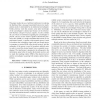Free Online Productivity Tools
i2Speak
i2Symbol
i2OCR
iTex2Img
iWeb2Print
iWeb2Shot
i2Type
iPdf2Split
iPdf2Merge
i2Bopomofo
i2Arabic
i2Style
i2Image
i2PDF
iLatex2Rtf
Sci2ools
ICASSP
2009
IEEE
2009
IEEE
Fixed SINR solutions for the MIMO wiretap channel
This paper studies the use of artificial interference in reducing the likelihood that a message transmitted between two multiantenna nodes is intercepted by an undetected eavesdropper. Unlike previous work that assumes some prior knowledge of the eavesdropper's channel and focuses on the information theoretic concept of secrecy capacity, we also consider the case where no information regarding the eavesdropper is present, and we use the relative signal-to-interference-plusnoise-ratio (SINR) of a single transmitted data stream as our performance metric. A portion of the transmit power is used to broadcast the information signal with just enough power to guarantee a certain SINR at the desired receiver, and the remainder of the power is used to broadcast artificial noise in order to mask the desired signal from a potential eavesdropper. The interference is designed to be orthogonal to the information signal when it reaches the desired receiver, and we study the resulting relative S...
| Added | 18 Feb 2011 |
| Updated | 18 Feb 2011 |
| Type | Journal |
| Year | 2009 |
| Where | ICASSP |
| Authors | A. Lee Swindlehurst |
Comments (0)

